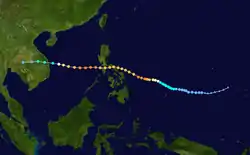Typhoon Trix (1952)
Typhoon Trix was an intense and deadly cyclone that struck Bicol region of the Philippines.
| Category 4 typhoon (SSHWS) | |
| Formed | October 15, 1952 |
|---|---|
| Dissipated | October 26, 1952 |
| Highest winds | 1-minute sustained: 220 km/h (140 mph) |
| Lowest pressure | 965 hPa (mbar); 28.5 inHg |
| Fatalities | 995 |
| Areas affected | Philippines |
| Part of the 1952 Pacific typhoon season | |
Meteorological history

Map plotting the track and the intensity of the storm, according to the Saffir–Simpson scale
Impact
| Rank | Storm | Season | Fatalities | Ref. |
|---|---|---|---|---|
| 1 | "Haiphong" | 1881 | 20,000 | [2] |
| 2 | Yolanda (Haiyan) | 2013 | 6,300 | [3] |
| 3 | Uring (Thelma) | 1991 | 5,101–8,000 | [4] |
| 4 | Pablo (Bopha) | 2012 | 1,901 | [4] |
| 5 | "Angela" | 1867 | 1,800 | [5] |
| 6 | Winnie | 2004 | 1,593 | [5] |
| 7 | "October 1897" | 1897 | 1,500 | [5][6] |
| 8 | Nitang (Ike) | 1984 | 1,363 | [4] |
| 9 | Sendong (Washi) | 2011 | 1,268 | [4][7] |
| 10 | Trix | 1952 | 995 | [4] |
Landslides and floods from the typhoon killed 995 people, making this typhoon one of the deadliest tropical cyclones in Philippine history.[8]
See also
- Typhoon Goni (2020) - the most powerful landfalling storm on record, beating Haiyan and Meranti, touching down on Bato, Catanduanes and Tiwi, Albay, as a Category 5 monster storm, causing severe flooding and the greatest lahar flow since Durian in 2006.
- Typhoon Melor (2015) - a Category 4 typhoon that struck Samar and Bicol.
References
- Kenneth R. Knapp; Michael C. Kruk; David H. Levinson; Howard J. Diamond; Charles J. Neumann (2010). 1952 Typhoon Trix (1952287N09148). The International Best Track Archive for Climate Stewardship (IBTrACS): Unifying tropical cyclone best track data (Report). Bulletin of the American Meteorological Society. Retrieved October 31, 2020.
- Philippine Storm Surge History. Project NOAH, University of the Philippines. November 23, 2013. Archived from the original on November 8, 2014. Retrieved November 29, 2013.
- del Rosario, Eduardo D. (April 2014). FINAL REPORT Effects of Typhoon YOLANDA (HAIYAN) (pdf) (Report). NDRRMC. Retrieved April 21, 2014.
- Alojado, Dominic (2015). Worst typhoons of the philippines (1947-2014) (pdf) (Report). Weather Philippines. Retrieved September 25, 2015.
- "10 Worst Typhoons that Went Down in Philippine History". M2Comms. August 3, 2016. Retrieved August 3, 2016.
- Lotilla, Raphael (November 20, 2013). "Flashback: 1897, Leyte and a strong typhoon". Rappler. Retrieved July 10, 2014.
- Ramos, Benito T. (February 10, 2014). Final Report on the Effects and Emergency Management re Tropical Storm SENDONG (WASHI) (pdf) (Report). NDRRMC. Retrieved February 10, 2014.
- "::..Typhoon2000.com: 30 Worst Typhoons of the Philippines (1947-2002)..::". Archived from the original on 2009-03-17. Retrieved 2015-06-09.
This article is issued from Wikipedia. The text is licensed under Creative Commons - Attribution - Sharealike. Additional terms may apply for the media files.
